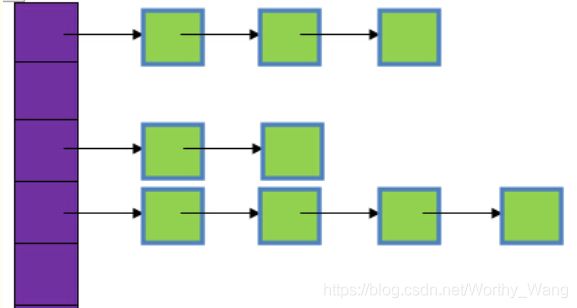STL 容器(三) map和unordered_map
文章目录
- 一.map
- 1.MemberFunction
- 2.Iterator
- 3.Capacity
- 4.Element access
- 5.Modifiers
- 6.Operations
- 二.map自定义排序
- 三.unordered_map
- 1.buckets
- 2.Hashpolicy
- 3.注意
- 四.unordered_map用法演示
STL unordered_map 与 map的区别:
1.map底层实现原理是红黑树,unordered_map实现底层原理是哈希表
2.map对key值进行自动排序,unordered_map则是随机插入不排序
3.map在插入,查找上都比unordered_map更耗时间,但是内存消耗小;unordered_map则反之
一.map
1.MemberFunction
- constructor
void test1() {
map<char, int> first;
first['a'] = 97;
first['b'] = 98;
first['c'] = 99;
map<char, int>second(first);
map<char, int> third(second.begin(), second.end());
}
- operator =
void test2() {
map<char, int> first;
first['a'] = 97;
first['b'] = 98;
first['c'] = 99;
map<char, int> second = first;
first = map<char, int>();
cout << "first.size() = " << first.size() << endl;
cout << "second.size() = " << second.size() << endl;
}
2.Iterator
- std::begin()/end()
void test3() {
map<char, int> mymap;
mymap['a'] = 97;
mymap['b'] = 98;
mymap['c'] = 99;
for (map<char,int>::iterator it = mymap.begin(); it != mymap.end(); it++) {
cout << "mymap[" << (*it).first << "] = " << (*it).second << endl;
}
}
- std::rbegin()/rend() ,r 表示reverse,表示从尾向前
void test4() {
map<char, int> mymap;
mymap['a'] = 97;
mymap['b'] = 98;
mymap['c'] = 99;
for (map<char,int>::reverse_iterator it = mymap.rbegin(); it != mymap.rend(); it++)
cout << "mymap[" << (*it).first << "] = " << (*it).second << endl;
}
- map.crbegin()/crend() cr 表示 const_reverse ,const修饰后不能修改
void test5() {
map<char, int> mymap;
mymap['a'] = 97;
mymap['b'] = 98;
mymap['c'] = 99;
for (map<char, int>::const_reverse_iterator it = mymap.crbegin(); it != mymap.crend(); it++)
cout << "mymap[" << (*it).first << "] = " << (*it).second << endl;
}
3.Capacity
- empty()/size()/max_size()
void test6() {
map<char, int> mymap;
mymap['a'] = 97;
mymap['b'] = 98;
mymap['c'] = 99;
cout << "mymap.size() = " << mymap.size() << endl;
while (!mymap.empty()) {
cout << mymap.begin()->first << "->" << mymap.begin()->second << endl;
mymap.erase(mymap.begin());
}
cout << "mymap.size() = " << mymap.size() << endl;
cout << "mymap.max_size() = " << mymap.max_size() << endl;
}
4.Element access
- operator[]/at
void test7() {
map<char, int> mymap{ {'a',97},{'b',98},{'c',99} };
cout << mymap['a'] << endl;
cout << mymap[0] << endl;//如果是没有定义的表,那么默认取空值
mymap.at('a') = 111;//at可以找出表中对应的信息进行修改
cout << mymap['a'] << endl;
mymap.at('d') = 123;//这里会报错,因为at的本质是寻找,并不能进行创造
cout << mymap['d'] << endl;
}
5.Modifiers
- insert
void test8() {
//1.single element
std::map<char, int> mymap;
mymap.insert(std::pair<char, int>('a',97));
mymap.insert(std::pair<char, int>('b', 98));
//2.with hint 尽管是通过insert进行插入,但是在map中仍然会自动修改位,对it->first进行从小到大排列
mymap.insert(mymap.begin(), std::pair<char, int>('c', 99));
//3.range
std::map<char, int> newmap{ {'d',100}, {'e',101} };
mymap.insert(newmap.begin(), newmap.end());
//print mymap
for (std::map<char, int>::iterator it = mymap.begin(); it != mymap.end(); it++) {
std::cout << "mymap[" << it->first << "]->" << it->second << "\n";
}
//print newmap
for (std::map<char, int>::iterator it = newmap.begin(); it != newmap.end(); it++) {
std::cout << "newmap[" << it->first << "]->" << it->second << "\n";
}
}
- erase 清除数据可以通过位置、范围、值进行清除
void test9() {
std::map<char, int> mymap{ {'d',100}, {'a',97},{'b',98},{'c', 99} };
//1.hint 这里迭代器的position其实本质上就是指针
std::map<char, int>::iterator it = mymap.find('b');
mymap.erase(it);
//2.hint val
mymap.erase(99);
//3.range
//mymap.erase(mymap.begin(), mymap.end());
//print mymap
for (std::map<char, int>::iterator it = mymap.begin(); it != mymap.end(); it++) {
std::cout << "mymap[" << it->first << "]->" << it->second << "\n";
}
}
- swap/clear/emplace
void test10() {
std::map<char, int> map1{ {'d',100}, {'a',97},{'b',98},{'c', 99} };
std::map<char, int> map2{ {'e',101} };
map1.swap(map2);
map1.clear();
map1.emplace('a', 97);
map1.emplace_hint(map1.end(), 'b', 98);
//print map1
for (std::map<char, int>::iterator it = map1.begin(); it != map1.end(); it++) {
std::cout << "map1[" << it->first << "]->" << it->second << "\n";
}
}
6.Operations
- find/count 注意find返回的是迭代器,count 则能从一个集合里面找到哪些是属于map的
void test11() {
map<string, string> family{ {"wwx","son"},{"wj","dad"},{"lzq", "mom"} };
vector<string> people{ "wk", "wby", "wwx", "wj" };
for (auto& e : people) {
if (family.count(e))
cout << e << " is in my family as " << family.find(e)->second << endl;
else
cout << e << " is not in my family" << endl;
}
}
- lower_bound/upper_bound/equal_range lower_bound与upper_bound都是返回一个迭代器,用于先定一个最低和最高的范围,equal_range则是返回key相同的范围,本身无太大意义
void test12() {
std::map<char, int> mymap{ {'a',97},{'b',98},{'c',99},{'d',100} };
std::map<char, int>::iterator itlow = mymap.lower_bound('b');
std::map<char, int>::iterator itupper = mymap.upper_bound('c');
mymap.erase(itlow, itupper);
//print mymap
for (std::map<char, int>::iterator it = mymap.begin(); it != mymap.end(); it++) {
std::cout << "mymap[" << it->first << "]->" << it->second << "\n";
}
}
二.map自定义排序
map的结构是[key,value] ,在插入新元素的过程中会根据key进行自动排序,key值既可以是普通类型,指针类型,也可以是类类型,我们都可以对其进行排序。
#include 三.unordered_map
相比于map,unordered_map中引入了桶的概念,其实也就是哈希表的原理,左边紫色方框表示桶,用链表连接的绿色方框表示插入的元素,用桶来装元素,如图:

1.buckets
- bucket_count():因为是采用hash表方式存储,所以hashmap中元素的个数并不等于桶的个数;
桶的个数是随机分配的,各个元素以链表形式连接在桶后面。 - bucket.size(i):i表示第i个桶中拥有的元素的个数
- begin(i):i表示第i个桶的begin iterator
- end(i): i表示第i个桶的end iterator
- bucket(it->first):表示*it元素在哪一号桶中
void test1() {
unordered_map<string, string> hashmap{ {"China","Beking"},{"USA", "LA"},{"UA", "London"} };
cout << "The number of buckets:" << hashmap.bucket_count() << endl;
cout << "The number of Maxbuckets:" << hashmap.max_bucket_count() << endl;
cout << "遍历每个桶,从每个桶中遍历元素:" << endl;
for (int i = 0; i < hashmap.bucket_count(); i++) {
cout << i << "号桶有" << hashmap.bucket_size(i) << "个元素 ";
for (unordered_map<string, string>::iterator it = hashmap.begin(i); it != hashmap.end(i); it++) {
cout << it->first << "->" << it->second << " ";
}
cout << endl;
}
cout << "直接遍历所有桶中的元素 方法一:" << endl;
for (unordered_map<string, string>::iterator it = hashmap.begin(); it != hashmap.end(); it++) {
cout << it ->first << "->" << it->second << endl;
}
cout << "直接遍历所有桶中的元素 方法二:" << endl;
for (auto& e : hashmap)
cout << e.first << "->" << e.second << endl;
cout << "返回元素在哪一个桶:" << endl;
for (auto& e : hashmap) {
cout << e.first << "->" << e.second << "在" << hashmap.bucket(e.first) << "号桶" << endl;
}
}
2.Hashpolicy
- rehash(i):重新将桶的数量设置为 >= i
- reserve():与rehash类似,重新规定桶的数量
- load_factor():为加载因子,hashmap.size()/hashmap.bucket_count(),表示的是哈希表的填充程度;
加载因子越大,哈希表充填得越多,冲突可能性增大,查找成功率增大
加载因子越小,哈希表充填得越小,冲突可能性减小,查找成功率减小
void test2() {
unordered_map<string, string> hashmap{ {"China","Beking"},{"USA", "LA"},{"UA", "London"} };
cout << "桶的数量:" << hashmap.bucket_count() << endl;
hashmap.rehash(20);
cout << "after rehash, 桶的数量:" << hashmap.bucket_count() << endl;
cout << "加载因子为:" << hashmap.load_factor() << endl;
hashmap.reserve(3);
cout << "after reserve, 桶的数量:" << hashmap.bucket_count() << endl;
cout << "加载因子为:" << hashmap.load_factor() << endl;
cout << "最大加载因子为:" << hashmap.max_load_factor() << endl;
}
3.注意
- 注意hashmap 是随机存放数据的,与数据插入(或存放)的位置没有关系
void test3() {
std::unordered_map<std::string, std::string> mymap;
mymap.insert({ "china", "Beking" });
mymap.insert({ "UK", "London" });
mymap.insert({ "USA", "LA" });
for (auto& e : mymap)
cout << e.first << "->" << e.second << endl;
}
四.unordered_map用法演示
这里将类存放进入hash表,需要自定义的有两个地方:
- PointHasher: 哈希函数
- PointEqual:也就是哈希表中的存放比较
#include 
